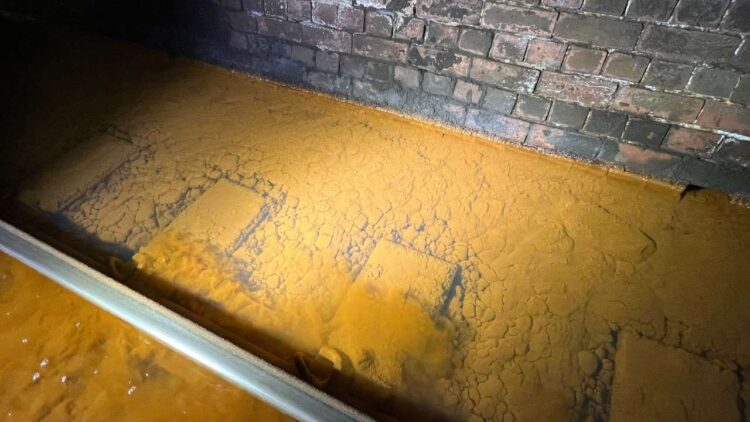Engineers have begun tests to find out how orange-coloured water is entering a railway tunnel on the Cumbrian Coast line.
The tunnel runs for one kilometre between Corkickle and Whitehaven. Because it sometimes floods, a culvert connects to Whitehaven. For many years, water has drained from the tunnel into the harbour via the culvert without any problem. However, since late last year, the water in Queens Dock has been a rusty colour.

Engineers suspect that iron ochre from historic mine workings in the area is causing the colour. So they are carrying out detailed tests to find out how and where it's getting into the tunnel.
Network Rail has spent several months appointing specialist contractors to carry out an hydrogeological survey to establish how the local topography, infrastructure, historic mining features and geology interact with the surface and groundwater in the local area.
The survey will generate a detailed picture to identify the source of the water which flows into Bransty Beck, some of which makes its way into and out of the tunnel drainage system.
Network Rail is working with the Environment Agency, Coal Authority and Whitehaven Harbour Commissioners to find a long-term solution to the problem, and all organisations hope that the survey will help to pinpoint sources of water containing dissolved iron. When exposed to the air, dissolved iron becomes rust-coloured, as seen in the railway tunnel and in the harbour.
Railway engineers have also been meeting retired miners in the area, to draw on their knowledge and expertise on where uncharted mine workings could be.
On Friday (10 November), Network released footage showing teams carrying out overnight inspections of the tunnel after train services stopped running at 10pm the previous night (Thursday 9 November).
Once engineers have identified the source of the water, the various agencies involved will work on long-term measures to mitigate, reduce and hopefully stop the problem. However, they are currently unable to say how long this could take.
The work will also help identify ways in which Network Rail can tackle the issue of water entering the tunnel and improve its drainage systems. Flooding in the tunnel sometimes causes the Cumbrian Coast line to close to trains, causing disruption to passenger and freight services., and improved drainage may reduce this problem.
Tests will continue for several weeks, and while the situation continues, trains will run at a 20mph instead of their usual 40mph, which will cause delays to passenger journeys. Network Rail is advising passengers to check the national rail website for information about the impact on journeys on the Cumbrian Coast line.
Phil James, Network Rail's North West route director said: “We know this complex investigation work is causing frustration as it's taking a long time, so we thank harbour users, rail passengers and local people for their continued patience.
“We're committed to working with the Environment Agency and Coal Authority to find the source of the water impacting our railway tunnel and the harbour so we can plan next steps to find a solution together. Solving this is also important for our passengers and freight, whose journeys we hope will be made more reliable and faster once the source of the mysterious orange water is made clear.”
Pete Miles, Environment Agency area environment manager, said: “Analysis of water samples from Whitehaven Harbour found no evidence of sewage pollution. The results did show some increased metals in the water and we are working with Network Rail who are actively investigating this further to determine the potential source.
“People can report environmental concerns to the Environment Agency on 0800 807060.”
Andy Morritt, Coal Authority head of environment strategy and sustainability, said: “We are continuing to provide assistance and expertise as required to support Network Rail's investigations.”
Stop water getting into the tunnel, does this mean they going to cover the ventilator stacks to stop ingress?
“Tests will continue for several weeks, and while the situation continues, trains will run at a 20mph instead of their usual 40mph, which will cause delays to passenger journeys”.
I can’t imagine that reducing speed from 40mph to 20mph for just 1 kilometre (to mix units as the story does!) will make much of a difference to journey times, especially as these can vary anyway depending on whether trains have to stop at the several request stops on the line.